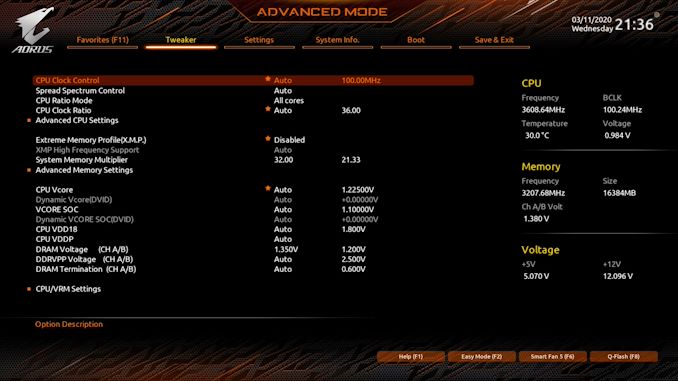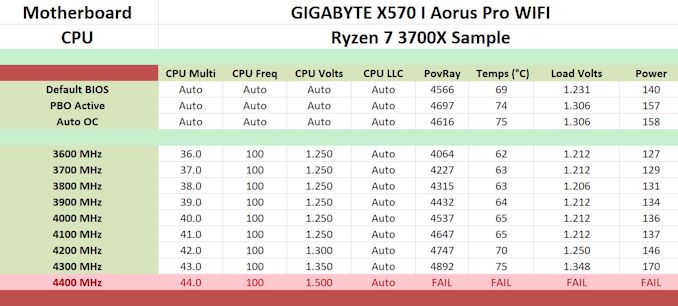On The Wings of an Eagle: GIGABYTE's X570 I Aorus Pro WIFI Motherboard Tested
by Gavin Bonshor on March 19, 2020 10:00 AM ESTOverclocking Ryzen 3000
Experience with the GIGABYTE X570 I Aorus Pro WIFI
It's no secret that Ryzen 3000 runs very warm when pushed beyond default settings and adequate cooling is a must. Our motherboard testing is focused on observing the behaviour and judging capability based on the hardware integrated onto the board including power delivery, circuitry, and other variables including the firmware which acts as the interface between the user and the hardware. One downside to mini ITX motherboards is that all the componentry is stacked tightly together and with this, it can produce more heat in comparison to other form factors with more sparse PCBs. This needs to be factored in when overclocking and it makes airflow even more important, especially in cramped spaces.
GIGABYTE's firmware is very easy to navigate around and all of the relevant overclocking settings can be found within the Tweaker section. Users doing basic overclocking can change key settings including CPU Ratio which will increase or decrease the CPU Core Frequency, and make CPU VCore adjustments for when the processor requires more juice to keep stable. Other important settings to consider include the CPU/VRM settings which allow users to select between different loadline calibrations, which can loosen or tighten the VDroop control for better stability in certain situations.
Memory overclocking can be achieved simply by enabling compatible memory with X.M.P 2.0 profiles or done manually by adjusting the memory frequency, the DRAM voltage, and adjusting latencies which can be found within the advanced memory settings menu. AMD recommends users keeping the FCLK (Infinity Fabric Clock) to within 2:1 of the memory frequency, with DDR4-3600 being the reported sweet spot between performance and frequency. For DDR4-3600, the FCLK should be set to 1800 MHz for best performance.
Overclocking Methodology
Our standard overclocking methodology is as follows. We select the automatic overclock options and test for stability with POV-Ray and OCCT to simulate high-end workloads. These stability tests aim to catch any immediate causes for memory or CPU errors.
For manual overclocks, based on the information gathered from the previous testing, starts off at a nominal voltage and CPU multiplier, and the multiplier is increased until the stability tests are failed. The CPU voltage is increased gradually until the stability tests are passed, and the process repeated until the motherboard reduces the multiplier automatically (due to safety protocol) or the CPU temperature reaches a stupidly high level (105ºC+). Our testbed is not in a case, which should push overclocks higher with fresher (cooler) air.
Overclocking Results
Our experience overclocking the GIGABYTE was a pleasant one and this board exceeded our expectations. For general users, GIGABYTE has gone with a very basic firmware with all the relevant settings in one easy to navigate place. As with all other X570 models tested, we managed to achieve 4.3 GHz on our Ryzen 7 3700X testbed processor with a CPU VCore of 1.350 V. All throughout our overclock testing, VDroop was tight with the LLC settings set to default, and we didn't experience any abnormalities in our testing.
Although GIGABYTE doesn't include any overclocking presets, the EasyTune software comes with a setting called Auto OC which labels itself as an automatic overclocking setting which we assumed is based on a basic lookup table. We didn't achieve any extra performance over enabling PBO, which proved slightly better than default settings at the cost of extra heat and power consumption. In our POV-Ray testing and testing from 3.6 to 4.3 GHz, performance increased gradually as expected.












63 Comments
View All Comments
InTheMidstOfTheInBeforeCrowd - Friday, March 20, 2020 - link
Hahaha, LOL... and respect, quite impressive. Makes me remember the old "Into the Shadows" demo from Triton (https://www.youtube.com/watch?v=kSRGLapSx3w).umano - Friday, March 20, 2020 - link
I really hope next x670 boards will support 2 m2 pcie at full speed, thunderbolt and 10gbe, at least on dtx size. I know I am dreaming but this is what I would really buyDug - Friday, March 20, 2020 - link
I wish you would test the parts of the motherboard that count, like networking, usb, sound, storage. Common Anantech. Get back to good reviews.It's getting old testing the same benchmarks that don't make any difference to users as they are all within a small percentage of each other.
qit - Saturday, March 21, 2020 - link
"same power stages that the flagship GIGABYTE X570 Aorus Xtreme is using, albeit in a smaller package with fewer phases."Does a power delivery stage with significant less phases (6 vs 16) actually qualify as "the same"?
Or is this more like a way of writing that wouldn't have appeared on anandtech years ago?
HardwareDufus - Saturday, March 28, 2020 - link
This looks like it could be my next motherboard. Would like it if it had optical audio (SPDIF), but that's okay.HardwareDufus - Saturday, March 28, 2020 - link
Dual M.2 and Dual HDMI is a very thoughful combination! So many folks like two harddrives and use two monitors...MetaCube - Tuesday, March 31, 2020 - link
Dual M.2 are quite popular, but that would be great if MB manufacturers could fuck off with video outputs.Qasar - Tuesday, March 31, 2020 - link
only way for that to happen, is if amd/intel made 2 product lines, cpu and motherboard, from top to bottom.watzupken - Monday, March 30, 2020 - link
I was considering getting this board together to be used with the 4xxx series APU later in the year, while using it with a 3400G. However one thing that I don't like is the sharing of the heatsink between the NVME drive and chipset. I guess there is very limited space to separate these 2, but I don't think its an ideal solution. I read on Amazon reviews that the SSD temps get quite high as a result. And yeah, not too thrilled with the idea of active cooling on the motherboard since it can be another point of failure.ForNein - Tuesday, April 7, 2020 - link
I'm confused.There is a complaint on page two about the lack of an M2 thermal pad on the chipset heatsink and then in the final picture and description you mention the inclusion of an M2 thermal pad.